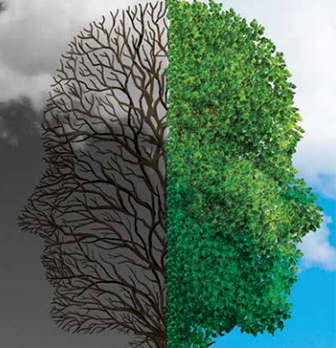
21 Apr Bipolar Disorder

Bipolar Disorder
By Mitra Keshtkar Jahromi, MD
Mitra Keshtkar Jahromi, MD
Mood is the quality of our feeling in a particular time which can fluctuates between sadness, depression, happiness, anger and excitement. All of us experience different levels of mood depends on our situations and experiences which is completely normal and most of the time are temporary. When the mood levels are so severe that affect person’s function and interpersonal interactions, it is called a disorder.
Major depression and bipolar disorders are major categories of mood disorders which are more common and is good to know about them. Bipolar means that the mood fluctuates between ends of spectrum of major depression and mania (or hypomania). Major depression is defined by feeling depressed or loss of interest to former pleasurable activities accompanied by at least four symptoms of difficulty sleeping, loss or gain in appetite, feeling guilt, loss of energy, feeling worthless, diminished concentration, slowness in motor activity and recurrent thoughts of death or at the worse scenario having thoughts or suicide for at least 2 weeks. Mania is a state of mood which is opposite of depression. It is defined of having elevated, excited or irritable feeling for at least one week accompanied by other symptoms including increased goal directed activities like being more productive at work, inflated self-esteem, decrease need for sleep, being more hyper talkative than usual, distractibility, subjective experiences of thought racing and excessive involvement in risky sexual behaviors and pleasurable activities like unrestrained buying or foolish business investments. Again, these symptoms should be severe enough to cause interpersonal and functional disturbances. Most of the patients don’t have insight toward their illness in their manic phase and denies their illness. In hypomania the patient might have above symptoms of mania but less severe which is not causing impairment in his or her function. On the contrary these patients might be more productive and functional in their job and their relationships, they spend more time at work, looks very cheerful and friendly, make jokes with friends and enjoy their mood. Actually, hypomania is very difficult to be diagnosed because the patients don’t look sick to general population and they need to be evaluated by a psychiatrist for diagnosis.
If the patient has episodes of mania and major depression, it is called bipolar I disorder and if he has episodes of major depression and hypomania is called bipolar II disorder. There are other types of mood disorders which do not have a typical presentation of mania, hypomania and major depression like people who have symptoms of mild chronic depression or episodes of atypical elevated mood which are categorized in other group of mood disorders and really hard to diagnosis or often being misdiagnosed if not evaluated by a psychiatrist.
It is very important not to miss secondary mood disorders due to substances and illicit drugs specifically these days that using substance are widespread in our modern societies. Substances and illicit drugs such as cocaine, marijuana, opiates, amphetamine, ecstasy and alcohol can sometimes cause severe mood disorders accompanied by aggressive behaviors. The main treatment for these mood disorders is to discontinue using drugs but not always the adverse effects are completely reversible. Besides the fact that, some times overusing or abrupt stoppage of the alcohol or drugs can pose a high risk.
Moreover, there are some medical conditions like endocrine disorders particularly hyper or hypo functioning of the thyroid, vitamin deficiency or brain tumors that can present with mood disorders. So, in first presentation of mood disorders, the psychiatrist should consider all medical causes of mood disorders.
Bipolar disorder might need to be treated by medications. Mood stabilizers such as Depakote, Lithium, Carbamazepine, Oxcarbazepine, Lamictal, Topiramate or some times other medications such as low to moderate dose of antipsychotic medications can be utilized to stabilize the mood.
At times, patient with bipolar disorder can pose a danger to self or others in acute phase of this disorder; such as a depressed patient with thoughts of suicide who end up attempting suicide; or a manic patient presenting with psychosis or high irritability and anger towards others contemplating to harm others. In these scenarios, patient needs to be admitted in the psychiatric unit of a hospital for necessary interventions and treatments.
We recommend reading this book:
The Bipolar Workbook: Tools for Controlling Your Mood Swings by Monica Ramirez Basco

